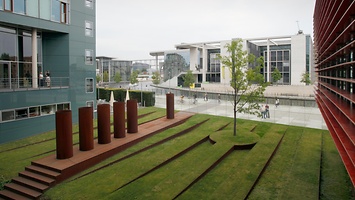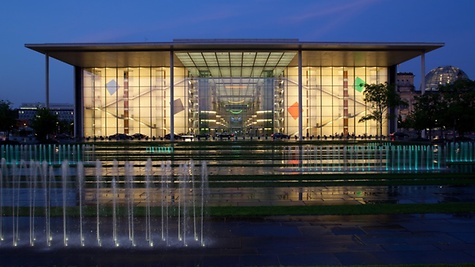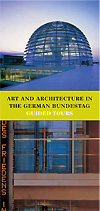Navigationspfad: Homepage > Art and History > Art
Selected works
Ellsworth Kelly
born on 31 May 1923 in Newburgh, Orange County, New York, died on 27 December 2015 in Spencertown, New York
Ellsworth Kelly, one of the best-known artists associated with “colour field painting” passed away shortly after Christmas at his house in Spencertown. He had been awarded the National Medal of Arts by President Barack Obama in 2013. This level of appreciation is also reflected in his 2008 creation of a 12-metre-high stainless steel column for the courtyard of the US Embassy in Berlin – the Berlin Totem – in the framework of the FAPE (Foundation for Art and Preservation in Embassies) programme. Ellsworth Kelly also created a prominent installation for the German Bundestag: the Berlin Panels 2000 . These four aluminium objects in blue, black, red and green are plainly visible through the glazed west facade of the Paul Löbe Building, where the clearly delineated colour fields strike a distinctive note.
Ellsworth Kelly belonged to a generation of post-war artists in the US who sought to achieve a form of art liberated from European traditions. The “New York School” with painters like Jackson Pollock, Robert Motherwell, Mark Rothko, Barnett Newman and Ad Reinhardt founded the abstract expressionism movement, as well as the hard-edge painting movement. Ellsworth Kelly, on the other hand, shaped by six years of study in France, was interested in the development of abstraction in Europe, absorbing influences from Kazimir Malevich and Paul Klee, Constantin Brancusi, Hans Arp and Sophie Taeuber-Arp, and developing his concept of “impersonal observation of form” (E.K.). He began by designing his works with an element of chance, in order to liberate his art from the duty of representing subjective and emotional moments. Later, he developed simple large geometric shapes – whether on canvas, as reliefs or sculptures – with clearly delineated edges and colourful monochrome surfaces. These objects have no meaning beyond themselves: they neither depict visual reality nor subjective emotions. Instead, they are self-contained objects which merely present to the observer their form and colour in the context of certain surroundings or backdrops.
Works consisting of several objects, such as the Berlin Panels 2000, follow this logic, made up of autonomous individual forms confirming their independence from any kind of relationship outside the work of art through repetition in various colours. At the same time, the wall becomes part of the installation: as the medium physically supporting the pictorial elements and also as part of the “pictorial space”; particularly since the observer repeatedly sees all four elements and compares the forms of the four diamonds with each other. They appear almost identical. Yet, in reality, the internal angles of these “diamond shapes” vary slightly. Kelly scattered the four colour fields across the facade in an elegant dance-like rhythm, creating an interplay with the lines of the stairs. In this way, his installation, in which any kind of “hierarchy has been eroded and replaced by a democracy of unlimited opportunities“ (Georg Imdahl), prepares people for the free and vibrant spirit of the building. Visitors entering the Paul Löbe Building are then drawn into the hall of the building, where French artist François Morellet provides a congenial variation on Ellsworth Kelly’s concept with his autonomous objects of colour and form, four illuminated neon tubes.
Text: Andreas Kaernbach, Curator of the German Bundestag's Art Collection










